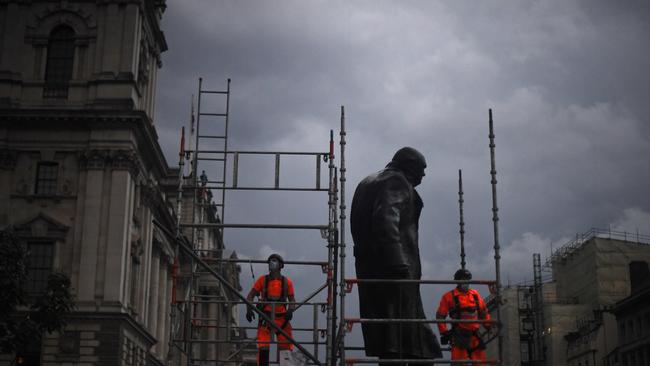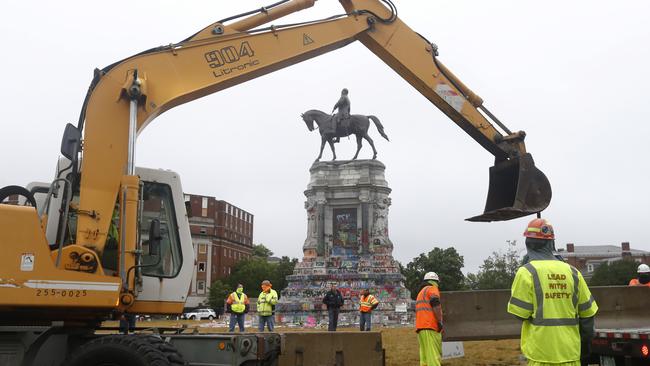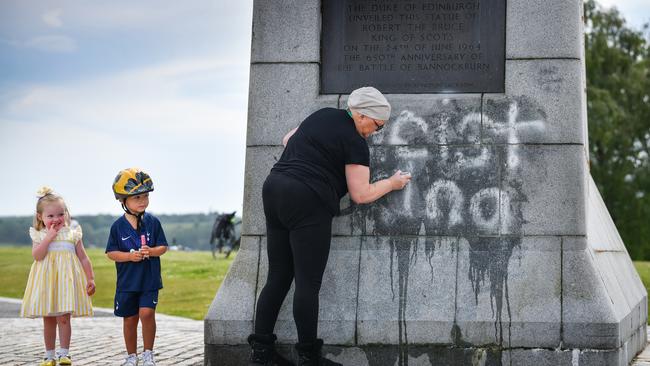George Floyd and the crashing of history’s symbols
The George Floyd protests have morphed into a broader campaign that’s sweeping the globe.

Yet this statue, once deemed untouchable, has become ground zero in the fast-widening push to haul down statues and attack symbols of slavery and black oppression across the country in the wake of the police killing of George Floyd.
The base of the Lee statue is covered in slogans from “blood on your hands” to “hold cops accountable”, and people climb on it to make speeches denouncing slavery and police violence towards blacks. A black gospel band even turns up to play at its base.
Yet among those visiting is a young woman dressed in a civil war-era hoop skirt who touches the statue reverentially and says: “I am a Confederate woman during the 1860s and I support Lee. We wanted to see this monument before they take it down. I’m very sad to see the markings on it. It’s such a beautiful piece of history. There was nothing racist about Robert E. Lee.”
As she speaks, the statue’s future is caught in no-man’s land, much like the furious debate erupting across the US over race and history.
Virginia’s Democratic Governor, Ralph Northam, has pledged to tear down the Lee statue.
“Virginia has never been willing to deal with symbols. Until now,” Northam says. “It was wrong then, and it’s wrong now, so we’re taking it down.”
But those who want the statue to stay have taken legal action to prevent its removal. So for now the bronzed Lee — symbol of slavery to some, historical hero of the old south to others — stares down on the divisions consuming America over how to reckon with its racial history.
All over the US, the protests that began with the death of Floyd have morphed into something far broader and less definable than police violence against African-Americans.
The initial mass protests of Floyd’s death at the hands of a Minneapolis police officer late last month have turned into a movement against all symbols of racial oppression, many of which bear no connection to police violence and some of which bear no connection to African-Americans.
Confederate statues have been targeted most, with dozens falling across the country in recent weeks as the old debate about what they represent — last sparked by a 2015 mass murder at a black church in Charleston, South Carolina, and again in 2017 by a white nationalist rally in Charlottesville, Virginia — is reignited on the largest scale yet by Floyd’s death.

Yet now the post-Floyd protesters in the US also are toppling statues and destroying symbols that have nothing to do with African-Americans.
In Richmond, the statue of Italian explorer and coloniser Christopher Columbus was set on fire and dumped into a river while other statues of Columbus were defaced around the country. In Philadelphia, about 100 people, some armed with guns, gathered around the city’s Columbus statue to protect it.
“Absolutely, we need to have a broader discussion about our history,” says Christine Flowers, an Italian-American lawyer who helped defend the statue. “(But) it is indefensible to try to erase that history by pulling down something that is very dear and very symbolic for the culture of Italian-Americans in Philadelphia.”
In Albuquerque, New Mexico, a violent clash between protesters and local militia members erupted this week over efforts to topple a statue of Juan de Onate, a 16th-century colonial governor with a reputation for cruelty towards Native Americans.
In Washington this week, the statue of pacifist Mohandas Gandhi outside the Indian embassy was covered up to protect it from attack in scenes repeated around the world as authorities moved to protect statues with few racial connotations such as wartime leader Winston Churchill in London and explorer James Cook in Australia. In the US other institutions, including corporate giants, have taken heed of the current mood and moved to reappraise symbols or brands that could be construed as racist.
The US Marine Corp and the NASCAR car racing group now have banned the use of Confederate flags. Among numerous examples, country band Lady Antebellum changed its name to Lady A, HBO Max temporarily pulled the movie classic Gone With the Wind and Quaker Oats said it was changing the name and packaging of its Aunt Jemima brand syrup and pancake mix because they were based on a racial stereotype.
But the morphing of the Floyd police protest movement into a broader campaign, including statue toppling, has divided opinion in the US, ending the broadly bipartisan support for police reform in the wake of Floyd’s death.
Many Republican voters who were sympathetic to the initial protests have baulked as the movement evolves into one of attacks on statues and the so-called “cancel culture” of withdrawing movies such as Gone With the Wind on the ground of political correctness.
President Donald Trump has long opposed the removal of what he called “our beautiful” Confederate statues and monuments, saying their destruction amounted to the “ripping apart” of America’s history and culture.

“You can’t change history, but you can learn from it. Robert E Lee, Stonewall Jackson — who’s next, Washington, Jefferson? So foolish!” Trump tweeted in 2017.
This week, Trump quickly slapped down the Pentagon after it said it was open to renaming army bases named after Confederate officers in the civil war.
“It has been suggested that we should rename as many as 10 of our Legendary Military Bases, such as Fort Bragg in North Carolina, Fort Hood in Texas, Fort Benning in Georgia, etc. These Monumental and very Powerful Bases have become part of a Great American Heritage, and a history of Winning, Victory, and Freedom,” Trump tweeted.
“The United States of America trained and deployed our HEROES on these Hallowed Grounds, and won two World Wars. Therefore, my Administration will not even consider the renaming of these Magnificent and Fabled Military Installations.”
Trump has tried to steer a middle course this week by introducing modest new guidelines to spur police reform without undermining his self-proclaimed stance as the “law and order” President during these weeks of racial upheaval. Some believe that protest movements such as Black Lives Matter have overreached by reigniting the divisive debate over Confederate statues and calls to “defund the police” by reallocating police money to social programs.
The Wall Street Journal columnist Jason Riley argues that even many black voters have reservations about where the movement is heading: “Most black people know that George Floyd is no more representative of blacks than Derek Chauvin is of police officers … and they know that the rioters are opportunists, not revolutionaries. There’s nothing wrong with having a national conversation about better policing, but this one has turned into a conversation about blaming law enforcement for social inequality, which is not only illogical but dangerous.”
But others believe the events of the past few weeks represent a historic tipping point, not only in race relations in the US but also on the vexed issue of Confederate statues and monuments.
Poopoo Earls, an African-American woman who protested in 1968 on the streets of Washington after the death of Martin Luther King Jr, says the Floyd protests have been very different because they include whites, Latinos and Asians.
“We ain’t never seen nothing like that,” she says of the Floyd protests. “We ain’t never had that many caucasians, all walks of life, walk with us … 68 wasn’t like that.”
Don Taylor, a professor of public policy at Duke University, says there has been a profound shift in attitudes towards Confederate symbols since Floyd’s death.
“It feels to me, with Confederate symbols, a bit like the gay marriage debate, where it seemed impossible, impossible, impossible, and then all of a sudden there was a huge shift in public opinion on it,” says Taylor.
Those who believe something has fundamentally shifted point to a Gallup poll this week that found 19 per cent of Americans cited race relations or racism as the most important problem facing the US. This was up from 4 per cent last month and was the highest rate since 1968, according to Gallup.
“It does look like there’s critical mass now and maybe people are listening in a way they didn’t before,” Karen Cox, a historian at the University of North Carolina who is writing a book on Confederate monuments, told The Washington Post.
But Cox says there are more than 700 Confederate monuments left and the wave of statue toppling will not solve the divisions over the issue.
“There’s a long history since the civil rights movement of actions against the monuments, especially after the Charleston massacre and after Charlottesville,” she says. “This is the same exact debate we’ve seen since the end of the civil war, and we still have the same national divide over immigration and race and what kind of south we will have. The white southerners will always say this is about heritage, and the black southerners will always say that the monuments are an insult.”
Others worry that this wave of statue-toppling will end up diverting attention from the original purpose of the protests, which was to prevent a repeat of tragedies such as Floyd’s death at the hands of police.
As one protester, Alisha Sonnier, said in St Louis, the pulling down of statues could be seen as an “easy appeasement” for the wave of anger. “(But) the statue being removed is not going to stop anyone from dying,” she says. “It’s not going to save a life.”
Cameron Stewart is also US contributor for Sky News Australia.


In Richmond, Virginia, the former capital of the Confederacy, the towering statue of Confederate general Robert E. Lee has stood for 130 years on Monument Avenue, arguably America’s best-known symbol of the old south.